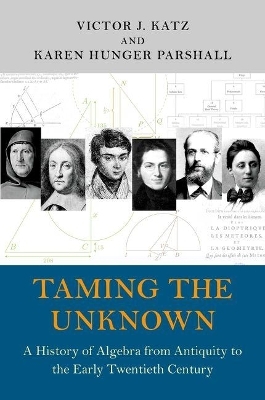
Taming the Unknown
Princeton University Press (Verlag)
978-0-691-14905-9 (ISBN)
What is algebra? For some, it is an abstract language of x's and y's. For mathematics majors and professional mathematicians, it is a world of axiomatically defined constructs like groups, rings, and fields. Taming the Unknown considers how these two seemingly different types of algebra evolved and how they relate. Victor Katz and Karen Parshall explore the history of algebra, from its roots in the ancient civilizations of Egypt, Mesopotamia, Greece, China, and India, through its development in the medieval Islamic world and medieval and early modern Europe, to its modern form in the early twentieth century. Defining algebra originally as a collection of techniques for determining unknowns, the authors trace the development of these techniques from geometric beginnings in ancient Egypt and Mesopotamia and classical Greece. They show how similar problems were tackled in Alexandrian Greece, in China, and in India, then look at how medieval Islamic scholars shifted to an algorithmic stage, which was further developed by medieval and early modern European mathematicians.
With the introduction of a flexible and operative symbolism in the sixteenth and seventeenth centuries, algebra entered into a dynamic period characterized by the analytic geometry that could evaluate curves represented by equations in two variables, thereby solving problems in the physics of motion. This new symbolism freed mathematicians to study equations of degrees higher than two and three, ultimately leading to the present abstract era. Taming the Unknown follows algebra's remarkable growth through different epochs around the globe.
Victor J. Katz is professor of mathematics emeritus at the University of the District of Columbia. Karen Hunger Parshall is professor of history and mathematics at the University of Virginia.
Acknowledgments xi 1 Prelude: What Is Algebra? 1 Why This Book? 3 Setting and Examining the Historical Parameters 4 The Task at Hand 10 2 Egypt and Mesopotamia 12 Proportions in Egypt 12 Geometrical Algebra in Mesopotamia 17 3 The Ancient Greek World 33 Geometrical Algebra in Euclid's Elements and Data 34 Geometrical Algebra in Apollonius's Conics 48 Archimedes and the Solution of a Cubic Equation 53 4 Later Alexandrian Developments 58 Diophantine Preliminaries 60 A Sampling from the Arithmetica: The First Three Greek Books 63 A Sampling from the Arithmetica: The Arabic Books 68 A Sampling from the Arithmetica: The Remaining Greek Books 73 The Reception and Transmission of the Arithmetica 77 5 Algebraic Thought in Ancient and Medieval China 81 Proportions and Linear Equations 82 Polynomial Equations 90 Indeterminate Analysis 98 The Chinese Remainder Problem 100 6 Algebraic Thought in Medieval India 105 Proportions and Linear Equations 107 Quadratic Equations 109 Indeterminate Equations 118 Linear Congruences and the Pulverizer 119 The Pell Equation 122 Sums of Series 126 7 Algebraic Thought in Medieval Islam 132 Quadratic Equations 137 Indeterminate Equations 153 The Algebra of Polynomials 158 The Solution of Cubic Equations 165 8 Transmission, Transplantation, and Diffusion in the Latin West 174 The Transplantation of Algebraic Thought in the Thirteenth Century 178 The Diffusion of Algebraic Thought on the Italian Peninsula and Its Environs from the Thirteenth Through the Fifteenth Centuries 190 The Diffusion of Algebraic Thought and the Development of Algebraic Notation outside of Italy 204 9 The Growth of Algebraic Thought in Sixteenth-Century Europe 214 Solutions of General Cubics and Quartics 215 Toward Algebra as a General Problem-Solving Technique 227 10 From Analytic Geometry to the Fundamental Theorem of Algebra 247 Thomas Harriot and the Structure of Equations 248 Pierre de Fermat and the Introduction to Plane and Solid Loci 253 Albert Girard and the Fundamental Theorem of Algebra 258 Rene Descartes and The Geometry 261 Johann Hudde and Jan de Witt, Two Commentators on The Geometry 271 Isaac Newton and the Arithmetica universalis 275 Colin Maclaurin's Treatise of Algebra 280 Leonhard Euler and the Fundamental Theorem of Algebra 283 11 Finding the Roots of Algebraic Equations 289 The Eighteenth-Century Quest to Solve Higher-Order Equations Algebraically 290 The Theory of Permutations 300 Determining Solvable Equations 303 The Work of Galois and Its Reception 310 The Many Roots of Group Theory 317 The Abstract Notion of a Group 328 12 Understanding Polynomial Equations in n Unknowns 335 Solving Systems of Linear Equations in n Unknowns 336 Linearly Transforming Homogeneous Polynomials in n Unknowns: Three Contexts 345 The Evolution of a Theory of Matrices and Linear Transformations 356 The Evolution of a Theory of Invariants 366 13 Understanding the Properties of "Numbers" 381 New Kinds of "Complex" Numbers 382 New Arithmetics for New "Complex" Numbers 388 What Is Algebra?: The British Debate 399 An "Algebra" of Vectors 408 A Theory of Algebras, Plural 415 14 The Emergence of Modern Algebra 427 Realizing New Algebraic Structures Axiomatically 430 The Structural Approach to Algebra 438 References 449 Index 477
| Erscheint lt. Verlag | 21.7.2014 |
|---|---|
| Zusatzinfo | 3 Maps |
| Verlagsort | New Jersey |
| Sprache | englisch |
| Maße | 152 x 235 mm |
| Gewicht | 964 g |
| Themenwelt | Mathematik / Informatik ► Mathematik ► Algebra |
| Mathematik / Informatik ► Mathematik ► Geschichte der Mathematik | |
| Mathematik / Informatik ► Mathematik ► Logik / Mengenlehre | |
| ISBN-10 | 0-691-14905-4 / 0691149054 |
| ISBN-13 | 978-0-691-14905-9 / 9780691149059 |
| Zustand | Neuware |
| Haben Sie eine Frage zum Produkt? |
aus dem Bereich


